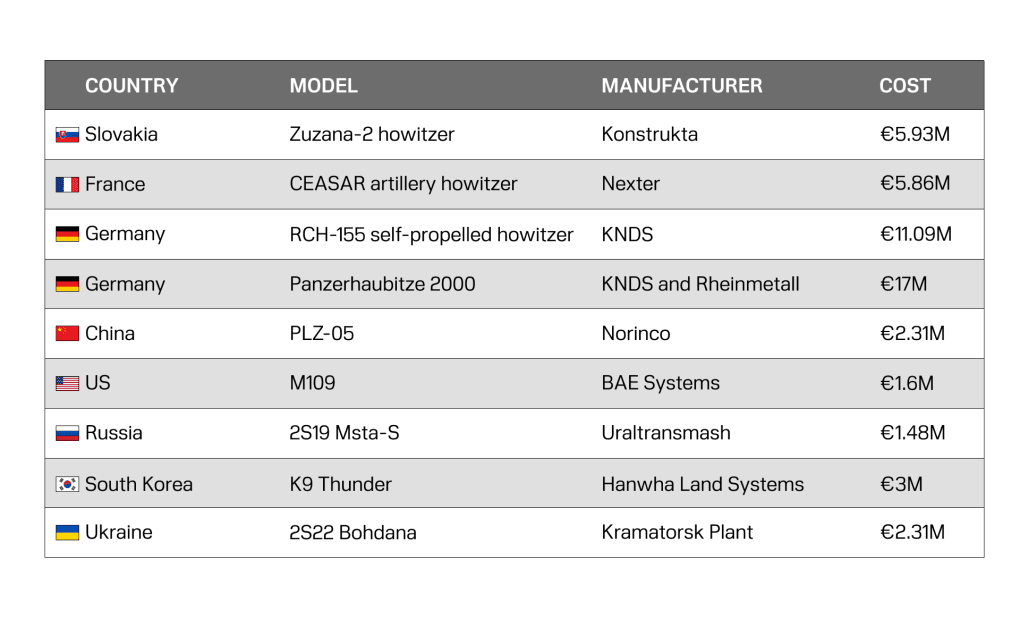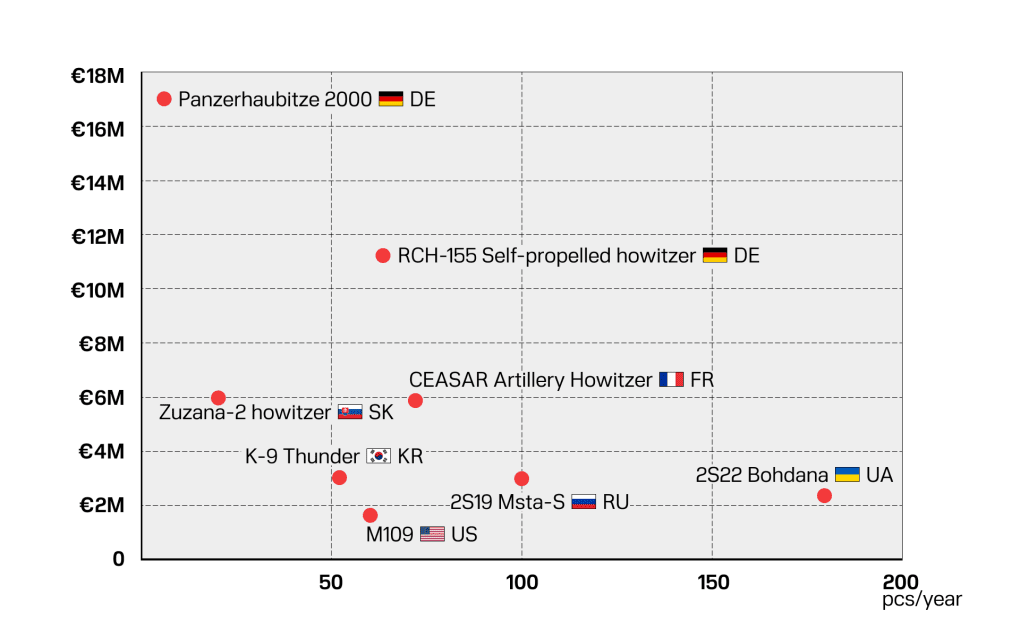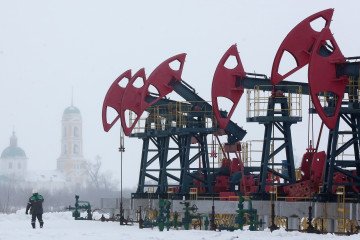- Category
- War in Ukraine
CAESAR, K9, Panzerhaubitze 2000: What Do the World’s Top Artillery Systems Cost?
-64b8d933918018078f225d66de9306f7.png)
From Germany’s almost $18 million Panzerhaubitze to Ukraine’s affordable Bohdana, self-propelled artillery comes with a hefty price tag—and a critical role in modern warfare.
Self-propelled artillery systems are the backbone of offensive and defensive strategies worldwide. Yet, only a few nations can produce these advanced weapons, especially on an industrial scale. A Bruegel think tank’s report, based on data from the Kiel Institute and open sources, breaks down the production rates and costs of the world’s leading models. UNITED24 Media presents the key takeaways.
Nine key self-propelled artillery systems
Nine self-propelled artillery systems from Europe and Asia were analyzed, showcasing a range of costs and capabilities:
Russia — 2S19 Msta-S: €1.47 million
USA — M109: €1.6 million
Ukraine — 2S22 Bohdana: €2.3 million
China — PLZ-05: €2.3 million
South Korea — K9 Thunder: €3 million
France — CAESAR: €5.83 million
Slovakia — Zuzana-2: €5.93 million
Germany — RCH-155: €11 million
Germany — Panzerhaubitze 2000: €17 million
While many other models exist, the ability to produce even a small number annually is crucial to meeting global demand.

Ukraine is currently the most active producer, capable of manufacturing 15–20 Bohdana units per month, totaling approximately 200 annually. France follows with the Caesar, producing up to six units monthly. With its K9 Thunder, South Korea can produce over 50 units annually, and the country is actively scaling its production capabilities to meet high demand.
Overview of the featured self-propelled artillery systems

2S19 Msta-S (Russia)
A Soviet-era self-propelled howitzer that remains a cornerstone of Russia’s arsenal. Equipped with a Soviet 152 mm caliber, it offers a maximum firing range of 36 km, though its effective range is closer to 25 km. Annual production is about 100 units, costing around $1.7 million per unit.
M109 (USA)
An American self-propelled howitzer, developed in the 1960s, is still in service in the US and allied nations, including Ukraine. With a 155 mm caliber, its range is up to 30 km. The U.S. produces 60–70 units annually at a cost of $1.7 million each.
2S22 Bohdana (Ukraine)
This Ukrainian self-propelled howitzer entered mass production after the Russian full-scale invasion in 2022. With an annual production rate nearing 200 units, it stands out for its rapid scaling. The Bohdana features a 155 mm caliber and a range of 40–60 km. Each unit costs approximately $2.5 million, though funding limitations constrain further expansion.
PLZ-05 (China)
Developed in the early 2000s and adopted in 2008, this Chinese self-propelled gun has a 155 mm caliber and a range of 20–50 km, with some shells capable of reaching up to 100 km. Production rates are not publicly disclosed, and its price is $2.4 million.
K9 Thunder (South Korea)
Introduced in the 1990s, this South Korean self-propelled howitzer has a 155 mm caliber and a range of up to 60 km. Production exceeds 50 units annually, with a price of up to $3 million per unit.
CAESAR (France)
A highly mobile French self-propelled howitzer is frequently used in Ukraine. Denmark, for instance, donated its entire artillery stock to Ukraine. With a 155 mm caliber and a range exceeding 40 km, its production rate is six units per month, and the cost is approximately $6 million.
Zuzana-2 (Slovakia)
In production since 1998, this Slovakian self-propelled gun has been used by several nations, including Ukraine. It has a 155 mm caliber and a range of 40 km. Slovakia produces several dozen units annually at a price of $6 million each.
RCH-155 (Germany)
Germany’s most advanced self-propelled howitzer, introduced in 2014, sets itself apart with a fire rate of nine rounds per minute—outpacing competitors at 5–7 rounds per minute. It can fire while moving, making it effective against counter-battery operations. With a 155 mm caliber and a range of 40–55 km, Germany produces over 50 units annually, priced at $12 million each.
Panzerhaubitze 2000 (Germany)
This German self-propelled gun, in service since 1998, is gradually being replaced by the RCH-155. Its production rate has slowed, with units priced at up to $18 million. The Panzerhaubitze 2000 has a 155 mm caliber and a range of 30–55 km.
***
The Russian invasion of Ukraine has driven up both the prices and demand for self-propelled artillery systems globally. Manufacturers are investing in scaling production, but the process remains slow. Meanwhile, the parallel challenge of producing sufficient artillery shells underscores the broader need for industrial expansion in the defense sector.
-29a1a43aba23f9bb779a1ac8b98d2121.jpeg)
-6359eca46c72bde40a90abaaadd6eaa8.png)


-206008aed5f329e86c52788e3e423f23.jpg)
